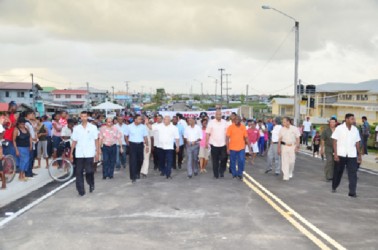A $350m bridge at Hope for the canal which will help to relieve flood pressure on the East Demerara Water Conservancy (EDWC) was commissioned on Saturday.
The bridge is one of four components of a massive $3.6b project orchestrated in the aftermath of the Great Flood of 2005. The other three parts are still to be completed despite several deadlines.
The project has four components: the Northern Relief channel which on completion will be 10.3km in length, from the sea defence embankment and extending to the EDWC, a high level outfall sluice, a conservancy head regulator and the public bridge.
The Government Information Agency said that at the inauguration ceremony,

President Donald Ramotar said that the EDWC Hope Canal Project will boost food security and foster other developments for Guyana.
“This is only part of (the) total infrastructure projects that we are planning in our country…for us really to have rapid economic growth and for us to improve the quality of our lives, we have to invest in infrastructure to facilitate and encourage economic development and so this is part of that whole project,” the President told the residents gathered, according to GINA. Noting that the project was conceived after repeated flooding was experienced, he said “I myself have gone in those areas in times when there were floods, and I could attest to the way it wrenched our hearts, you will be less than human if you went to see the condition that the people were in, water flooding their homes. I remember going at one time and speaking to people right up to their step from a boat”.
The President said what was distressing was seeing farmers putting in their labour and having to continuously witness it being destroyed or see their animals lost.
The commissioning of this phase of the project also addresses the issue of providing improved infrastructure for the growing number of vehicles that now traverse Guyana, GINA said.
The President expressed the hope that the other three components of the project will be accelerated so that the entire project can come on stream.
For the public bridge, the successful bidder was DIPCON at the contract sum of $349,654, 353, and the company started work on the bridge in August 8, 2011. The project was expected to be completed on February 4, 2013, but experienced two extensions, bringing the final date of November 30, 2013. The project duration of 18 months had to be revised to 27 months.
GINA said that the project faced many challenges during the construction phase. National Drainage and Irrigation Authority (NDIA) Head Lionel Wordsworth said that during the pile driving phase, the position of the crane was a challenge due to the limited working area on the western pier especially during the driving of the raking pile.
He added that the contractor originally said in their work proposal that the concrete beams for the bridge would be cast at DIPCON’s Onverwagt Plant, however it turned out that only the bearing piles and the 17.5m short piles could have been cast there.
“The longest 40m beams were considered too heavy, and there was no available truck capable to transport the long span beam. Also it was determined to be impossible to be traversed around some of the turns on the main roadway, between the plant yard and the site, and as such much more time had to be spent on site preparation work,” he explained, according to GINA. GINA said that the bridge has a length of 74.4m and a 47m sloped approach on both sides. As part of quality control as per contract and standard engineering guideline, Geotec Associates of Trinidad and Tobago was hired to undertake four tests on the pre-stressed concrete piles, to confirm the allowable bearing load for the foundation.
The bridge has a 12-month defects liability period, which commenced from Saturday, GINA said.
In mid-December last year, Wordsworth had told Stabroek News that the excavation of the Northern Relief Channel was 96% completed and trimming and shaping of embankments was continuing while stockpiled clay was being hauled to the section of the channel between the Crown Dam and the Conservancy Dam.
Meanwhile, the conservancy head regulator was 70% completed and the concrete base slab has been completed. Concrete works were being concentrated on the construction of the walls of the sluice structure which were near to completion, the NDIA head said.
“The high level outfall sluice is at 47% completion with works continuing on the casting of the base slab inclusive of the high level weir,” Wordsworth added then.





